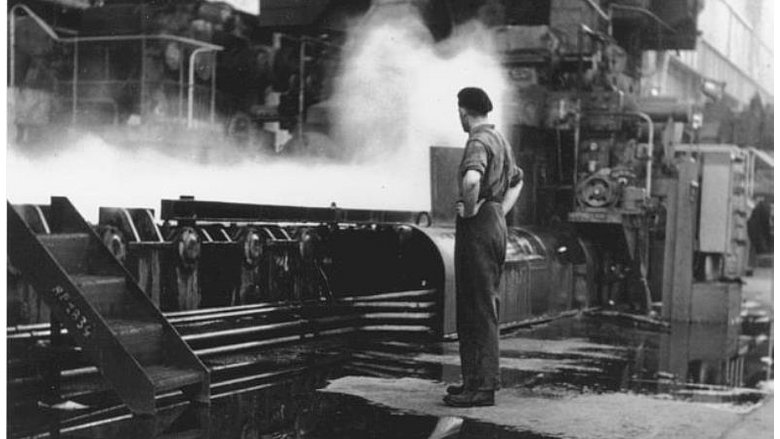2017 is the 70th anniversary of the signing of the World Bank’s first loan – a Reconstruction Loan to France in 1947. To mark the occasion, the World Bank Group Archives has publicly released records relating to the loan and made digitized versions of the records available through the World Bank’s Projects & Operations database. The digitized records, which consist of correspondence and memoranda relating to the negotiation, administration, and repayment of the 1947 loan, evidence the work involved in the execution of this seminal event in Bank history.
Initial Challenges

The World Bank's first President, Eugene Meyer, resigned abruptly in December 1946, without a clear successor. The Bank’s Vice President, Harold Smith, died suddenly on January 23, 1947. Although a few applications had been received, the Bank had thus far made no loans. However, the election on February 23, 1947, of John J. McCloy as the Bank’s second President marked the start of true operations in the World Bank. The Bank soon embarked on the preparation and execution of an important series of reconstruction loans to Western Europe countries, the first of which was to France.
The Loan Application


Appraisal
In his oral history, Richard H. Demuth, at that time Assistant to the World Bank's Vice President, recalled the challenge of appriasing what would become the Bank's first loan:
Loan Negotiations
In his autobiography, This Is the Way It Was, then Bank Vice President Robert L. Garner recalled that the loan negotiations were not without their difficulties:

Signing the Loan
France had originally applied for a loan of $500 million. The Bank agreed to half that amount, with the possibility of a second tranche. The relative amounts for each category in the overall requirements remained the same. The loan was signed on May 9, 1947. With this loan the Bank committed more than one third of its loanable funds held on June 1,1947. In real terms it is still the Bank's largest single loan, with a 1997 value of $2.6 billion.
The Bank’s Second Annual Report 1946/1947 assessed the circumstances surrounding the loan to France:

The Bank is fully aware of the uncertainties and difficulties facing France. Leaders of the French Government themselves have stated that they realize that unless France's budgetary difficulties are overcome, the ensuing fiscal instability will endanger the entire reconstruction program. Some of the factors impeding recovery are beyond the control of France. But to the extent that France has been able to speed her own recovery considerable success has been achieved. Her external debt record has been excellent. The Bank believes that its loan will hasten the process of reconstruction, that it will result in raising the level of France's productivity, and that the risks involved are of the type which the Bank was designed to accept.
Recovery in Western Europe
Further reconstruction loans to the Netherlands, Denmark and Luxembourg followed. Including the loan to France, the Bank loaned almost $500 million to postwar reconstruction efforts.

As part of the Bank’s fifteenth anniversary in 1961, Richard Demuth looked back on the accomplishments of the World Bank in the pages of the Bank’s internal staff newsletter, International Bank Notes. He describes both the risk involved in the Bank’s first loan and the ultimate reward:
In the winter of 1947 the prospects that Western Europe would achieve economic viability were bleak indeed. The financial requirements were immense and the countries of Western Europe had practically no foreign exchange reserves to help meet them. Indeed, the threat loomed large that the Western European economies would come to a standstill for want of dollars to keep essential food, fuel and raw material imports flowing in. The Bank's reconstruction loans were an emergency measure to meet this situation. It took a bit of stretching for the management to conclude that repayment prospects were reasonable; the economic report on France, for example, laid its stress, not on financial resources or specific export prospects, but on the French "collective will to recover." The Bank's gamble paid off handsomely, however, for it won time necessary for the European Recovery Program (the Marshall Plan) to be formulated and put into effect (with considerable help from the Bank's staff), with results that are now familiar history.
Sources:
“The Bank’s First Loan: $250 Million to France.” Bank Notes. Vol. 5, No. 6, pp. 16-17. May 1987.
Demuth, Richard H. “A Look Backward.” International Bank Notes¸ Vol. 15, No. 6, pp. 6-10. June 1961.
Demuth, Richard H. Transcript of oral history. World Bank Group Archives Oral Histories, August 10, 1961.
Doggart, Caroline, "From Reconstruction to Development in Europe and Japan" in Lateef, K. Sarwar, ed., The Evolving Role of the World Bank: Helping to Meet the Challenge of Development. Washington, D.C.: The World Bank, August 1995.
Garner, Robert L. This Is the Way It Was. Chevy Chase, Maryland: Chevy Chase Printing, 1972.
International Bank for Reconstruction and Development. Second Annual Report 1946/1947. Washington, D.C., 1947.

